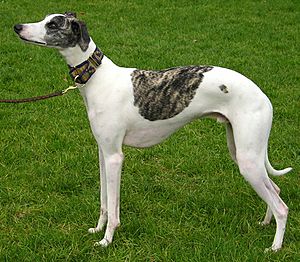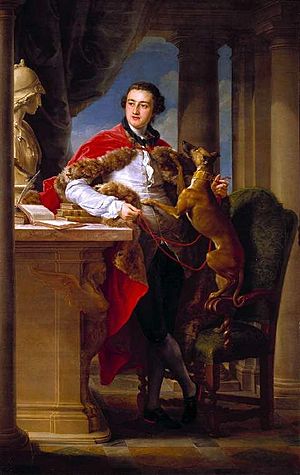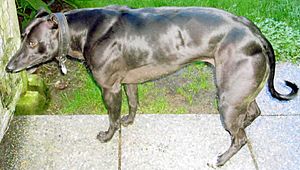Whippet facts for kids

A grey brindle and white Whippet
|
|||||||||||||||||||||||||||||||
| Other names | English Whippet or Snap dog | ||||||||||||||||||||||||||||||
|---|---|---|---|---|---|---|---|---|---|---|---|---|---|---|---|---|---|---|---|---|---|---|---|---|---|---|---|---|---|---|---|
| Origin | England | ||||||||||||||||||||||||||||||
|
|||||||||||||||||||||||||||||||
|
|||||||||||||||||||||||||||||||
| Domestic dog (Canis lupus familiaris) | |||||||||||||||||||||||||||||||
The Whippet (also called the English Whippet or Snap Dog) is a medium-sized dog breed. These dogs are a type of sighthound, meaning they hunt mainly by sight. Whippets first came from England and are related to Greyhounds. They still look a lot like smaller Greyhounds today.
Whippets are part of the Hound group. They are generally healthy dogs. Whippets are also great at dog sports like lure coursing, agility, dock diving, and flyball. The name "Whippet" comes from an old word that meant "to move quickly."
People sometimes call Whippets "the poor man's racehorse." They are popular pets and often take part in amateur racing and dog shows. Whippets are known for being the fastest dog breed for their size. They can also accelerate, or speed up, incredibly fast!
Contents
History of the Whippet

Whippets were first bred to hunt by sight. They would chase game in open areas at very high speeds. Paintings from Ancient Egypt show small dogs that look like Greyhounds. In medieval England, a small Greyhound-like dog became popular for catching rats. The word "Whippet" was first used for a type of dog in English in 1610.
Whippets were often called "snap dogs." This was because they would quickly "snap up" or catch prey nearby. A painting from the 1700s by Jean-Baptiste Oudry shows two dogs given to King Louis XV. These dogs might be early Whippets or small Greyhounds. Another painting from 1758 by Pompeo Batoni also shows a dog that looks like a Whippet.
In the 1800s, Whippet racing was very popular in parts of England. People in northern England and Wales thought highly of Whippets. At that time, there were two types of Whippets. One had a smooth coat and became the modern Whippet we know today. The other had a rough coat because it was mixed with Bedlington Terriers. This rough-coated type was often called a "rabbit dog."
The modern Whippet breed officially began in 1891. That year, The Kennel Club in England recognized the breed. This meant Whippets could compete in dog shows. In the United States, the American Kennel Club recognized Whippets in 1888. Whippets came to the U.S. with factory workers from England. The first groups of Whippets in America were in Massachusetts.
Whippets have won many top awards at dog shows. In 1964, a Whippet named Ch. Courtenay Fleetfoot of Pennyworth won "best in show" at the Westminster Kennel Club Dog Show. Other Whippets have won "best in show" at Crufts, a famous dog show in England, in 1992, 2004, and 2018.
Whippet Racing
Dog racing started from an older sport called hare coursing. Whippets began to be bred for racing in the mid-1800s. The first type of Whippet racing was called 'ragging'. Dogs were "trained to the rag."
In these races, a person called a slip would hold the dogs on a leash. The slip was often also the race judge. The dogs would be released at the same time. They would then race towards their owners, who stood at the other end of the track. The owners would wave towels to get their dogs' attention.
Whippet rag races were popular Sunday events in England. There were also races in other countries, like Australia. Over time, the sport changed. Dogs were divided into groups based on what they chased. Some chased rabbits, some chased hares, some chased a rag, and some chased a mechanical lure. Many racing Whippets were not purebred. People cared more about breeding fast dogs than pure bloodlines.
In 1967, the British Whippet Racing Association was formed. It aimed to make rules for races with mixed-breed Whippets. A year later, the Whippet Club Racing Association was created. This group was only for purebred Whippets.
About the Whippet
Appearance
Whippets are medium-sized dogs. They usually weigh between 15 to 42 pounds (6.8 to 19.1 kg). Their height can vary a bit depending on where they are shown. In North America, male Whippets are usually 18.5 to 22.5 inches (47 to 57 cm) tall. Females are 17.5 to 21.5 inches (44 to 55 cm) tall. In other parts of the world, they are a little smaller. Males are 18.5 to 20 inches (47 to 51 cm) and females are 17.5 to 18.5 inches (44 to 47 cm).
Whippets come in many different colors and patterns. You can find them in solid black, solid white, red, fawn, brindle, blue, or cream. The color of a Whippet does not matter when they are judged in shows. However, The Kennel Club no longer registers Whippets with a merle coat color. This is because merle is not a natural color for the breed. Whippets have a short, smooth, and thin coat.
Whippets are the fastest dogs for their weight. They can run up to 35 miles per hour (56 km/h)! They can do this because of a special way they run called a double suspension gallop. In this running style, all four of the dog's legs are off the ground twice during each stride. This happens once when their legs are fully stretched out and again when they are tucked under their body.
Temperament
Whippets are usually quiet dogs and do not bark a lot. They need regular exercise to stay healthy and happy. They are generally gentle and calm dogs. Many Whippets are happy to spend a lot of the day resting. The American Kennel Club says they are "quiet and dignified" and make "excellent house dogs."
Whippet Health
Whippets have been bred for many years to run and work. This has helped them stay a very healthy breed. They usually do not have the extreme body features that can cause health problems in some other breeds. Like other sighthounds, Whippets can be sensitive to certain medicines used for surgery. This is partly because they have very little body fat.
With good food, exercise, and vet care, most Whippets live for 12 to 15 years. A study in the UK found that the average lifespan is about 12 years and 10 months. They are generally healthy and do not often get ear infections, skin allergies, or digestive problems. Eye problems are very rare in Whippets. Because of this, the American Whippet Club suggests that breeders test their dogs for these rare eye issues. Hip dysplasia, a problem with the hip joints, is also very rare in Whippets.
A Whippet's heart is large and beats slowly. It might even seem to beat unevenly when the dog is resting. This can sometimes worry owners or vets who are not familiar with the breed. However, a Whippet's heartbeat will become regular when it exercises. A health survey found that heart problems were the second most common cause of death in Whippets.
In 2007, scientists found a special gene change in Whippets. This change is linked to how athletic they are. Whippets with one copy of this gene change are usually normal. But those with two copies have much larger muscles. These dogs are known as "bully whippets." Bully whippets do not have major health problems. They might just be more likely to get muscle cramps. This gene change has not been found in Greyhounds or other sighthound breeds. It also hasn't been seen in other very muscular dogs like Bullmastiffs or Rottweilers.
Whippets in Books
A Whippet named Jim was a main character in a series of books by Terry Darlington. These books were about traveling on canals. Jim was called a 'narrow dog,' and he gave his name to the book titles, such as Narrow Dog to Carcassonne.
See also
 In Spanish: Whippet para niños
In Spanish: Whippet para niños





